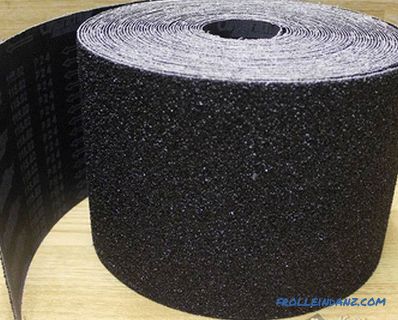Installation of the heating system is one of the most important works that are part of the construction of your home. Before you do the work, you must decide on the choice of scheme. It is possible to choose one-pipe or two-pipe. One-pipe heating system of a private house is much easier for self-installation. It is simple, but reliable and efficient. Moreover, its assembly will require much less material. Next, we consider how such a system can be made, and how it differs from a two-pipe one and what are its advantages.
Components
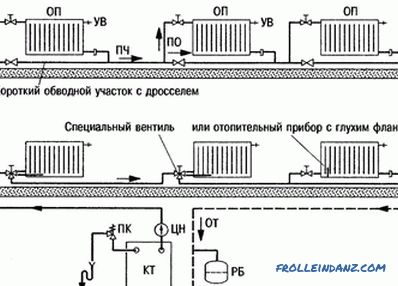 Scheme of one-pipe heating system
Scheme of one-pipe heating system
Let's look at how it works such a system.
- The base is a heating boiler that heats the heating medium. Often choose gas boilers. They are simple and reliable. In places where gas is not supplied, it is possible to use a unit operating on solid fuel.
- The elements of heating are standard radiators. When choosing them you should take into account that the old Soviet cast iron is better not to install. They are not able to provide proper heating of rooms and do not meet today's requirements. It is much more efficient to use new bimetallic radiators, which quickly heat up, have high heat transfer and look much more attractive.
- The expansion tank is an indispensable element of a one-pipe system. It acts as a pressure stabilizer, controlling the degree of expansion of the coolant. When the carrier is heated, its excess (associated with thermal expansion) enters the tank, preventing the system from having excessive pressure.
- The layout of the pipes through which heat is supplied. You can add drain valves and valves to it.
How does
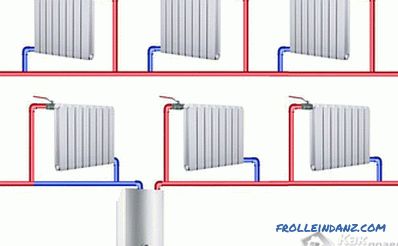 Work Principle
Work Principle
Scheme of such a heating system pretty straightforward. At the heart of everything is any boiler. It heats the coolant supplied through the pipe coming from the boiler. Why is such a scheme called one-pipe? Because along the entire perimeter one pipe is laid, which comes from the boiler and enters it. In the right places on the brackets are installed radiators and connected to the pipe. The heat carrier (most often water) moves from the boiler, filling the first radiator in the node, then the second and so on. At the end, the water returns to the starting point and the cycle repeats. There is a continuous circulation process.
It should be noted that having collected such a scheme, one may encounter one difficulty. Since the rate of advance of the coolant may be small, temperature loss may occur. Why? If we talk about the two-pipe system, then the principle of its operation is as follows: water flows into the battery through one pipe, out of it through the other. In this case, its movement passes immediately through all radiators, and there is no heat loss.
In a single-pipe system, the coolant enters all the batteries gradually and loses its temperature as it passes through them. So, if at the time of leaving the boiler, the temperature of the carrier was 60˚ C, passing through all pipes and radiators, it may drop to 50˚C. What to do in this case? To overcome these fluctuations, you can increase the heat capacity of the batteries at the end of the chain, increasing their heat transfer, or increase the temperature in the boiler itself. But all this will lead to additional costs that are unprofitable and make the cost of heating more expensive.
To get rid of such a problem without high costs, you need to increase the speed of the coolant through the pipes. There are 2 ways to do this:
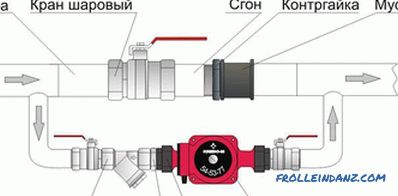 Technology of mounting the pump in the heating system
Technology of mounting the pump in the heating system
Install the circulating pump. So you can significantly increase the speed of water in the system. In this case, the heat loss at the outlet will be significantly reduced. The maximum loss can be several degrees. Such pumps are powered by electricity. It should be noted that for country houses, where electricity is often cut off, this option will not be ideal.
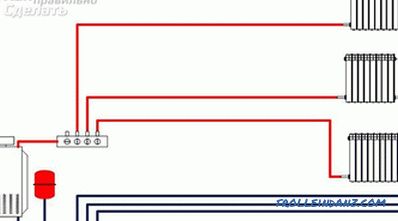 Install the collector immediately behind the boiler
Install the collector immediately behind the boiler
Install the booster collector. This is a high straight pipe, through which water, passing through it, is gaining great speed. Then the coolant in the system with natural circulation makes a full circle faster, which also solves the problem of heat loss. It is especially good to use such a method in a multi-storey building, since in a single-story building with low ceilings, work will be ineffective. For the normal functioning of the collector, its height should be greater than 2.2 m. You should know that the higher the accelerating collector is, the faster, more efficiently and quieter the movement in the pipeline will be.
In such a system, there must be an expansion tank, which is better to install at the top. It acts as a stabilizer, controlling the increase in coolant volume. How does he work? When heated, the volume of water increases.These surpluses enter the tank, preventing overpressure. When the temperature drops, the volume decreases and from the expansion tank flows back into the heating network.
That's the whole principle of the one-pipe heating system. This is a closed loop, which includes the boiler, main pipes, radiators, expansion tank and elements that provide water circulation. Distinguish forced circulation, when all the work is done by the pump, and natural, in which the upper collector is mounted. The difference with this design is that it does not provide a reverse-action pipe, through which the coolant returns to the boiler. The second half of this layout is called the return.
A single-pipe system can be of two types, depending on the installation: horizontal and vertical.
Advantages and disadvantages
To decide which system you need, consider the advantages and disadvantages of a one-pipe system.
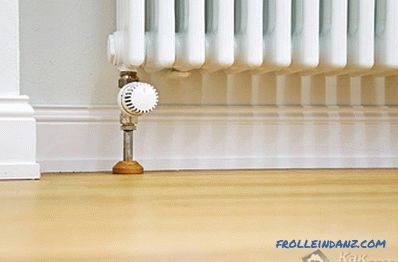 When mounting a single pipe pipe system, you can easily hide
When mounting a single pipe pipe system, you can easily hide
Pros:
- The only pipe system is mounted around the perimeter of the building, it can be hidden in the floor or in the walls.
- Thanks to this system, laying of the pipeline is possible under the door openings, the amount of consumable material and the cost of the whole structure are reduced.
- It is possible to gradually connect heating devices, as well as embed other elements of the heating circuit: heated floors, heated towel rails or radiators. Thanks to the parallel or serial connection method, the degree of battery heating becomes adjustable.
- Ability to connect several types of cats. You can install a gas, electric or solid fuel boiler. If one is disconnected, simply turn on the other.
- The direction of flow of water to where it will be more profitable for residents of the house. For example, at first you can send a hot stream to the children's room, where more heat is required or to the leeward side of the building.
- Unlike a two-pipe system, when choosing trunk pipes with a large diameter, they can serve as registers and also produce heat. Due to this, the perimeter of the building, walls and corners will not freeze.
- Even after all the work has been completed, you can additionally embed and install several more radiators.
- Minimum consumption of materials and efficiency.
- Easy installation and repair of the structure.
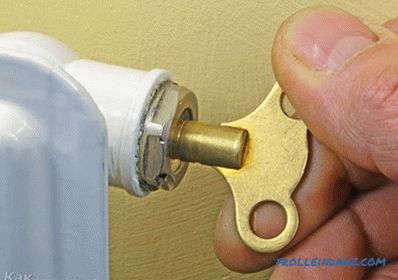 In such a system, it is often necessary to bleed air
In such a system, it is often necessary to bleed air
But with these virtues this systems and some drawbacks and inconveniences that should also be noted:
- If the required slope is not observed, air traffic jams may occur that reduce heat transfer.
- After a long non-working period, for example in the summer, it needs a long time to run.
- When carrying out repair work in a multi-storey building, it is impossible to disconnect one floor, you have to disconnect the entire building.
- Heat loss may occur during operation.
You should know this before you start installing the heating system of a private house.
How to make
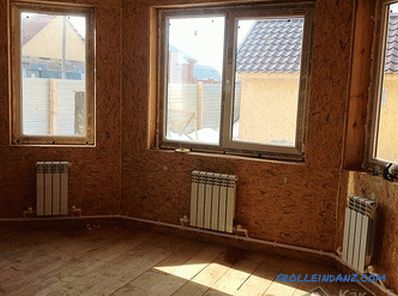 Batteries are connected to a single pipe system
Batteries are connected to a single pipe system
If you do everything from scratch, you need to ensure the availability of such materials:
- heating boiler;
- circulation pump;
- expansion tank;
- main pipes Ø25 mm and pipes Ø20 mm in order to connect radiators (you can choose any material: steel, plastic, copper, reinforced polyethylene);
- fittings to connect taps to radiators;
- the required number of radiators , gaskets and plugs;
- Mayevsky cranes, thanks to which You can remove air from each radiator;
- a filter that will be installed in front of the boiler for water treatment.
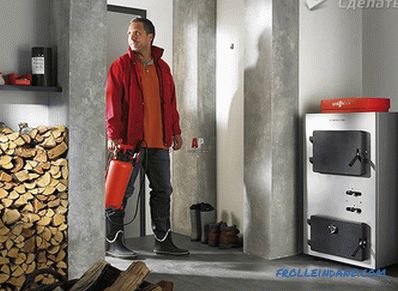 The solid fuel boiler is installed in the basement of the house
The solid fuel boiler is installed in the basement of the house
Further work sequence is as follows:
- You need to choose a place and install the boiler and filter. The incoming pipe is better to choose metal.
- Then the chimney is mounted. Connecting to the chimney is better to perform a corrugated metal pipe.
- Now we need to make the main pipeline. Pipes are laid along the perimeter of the whole house. It is important that the connection diagram is already available, since during installation it is necessary to immediately mount the fittings in places where radiators will stand. At the lowest point of the system, a drain valve is mounted through which the heating circuit can be filled with water or drained. It is important to withstand a certain degree when installing the pipeline: for a circuit with natural circulation it is 3˚-5˚, for forced movement (using a pump) - 10 mm per 1 meter of pipe.
- The pipeline along the entire perimeter must be fastened to the wall in order to eliminate deflections and air accumulation. For this you can use clips.
- A pump is placed in the selected location. It is cut into the main pipe in a place where there is a socket nearby. You should know that the pump, depending on the manufacturer, works flawlessly at temperatures not higher than 60˚, so the location on the return pipe near the boiler will be optimal.
- Now it's time to install an expansion tank. It is usually mounted near the boiler, at an altitude greater than 1.5 m.
- It remains only to install and connect radiators. In the right place they are fixed with brackets. To ensure air circulation, they do not need to be installed strictly under the window sill, the floor and with the wall butt. It is important to maintain a small distance.
- After installation, the radiators are connected according to the scheme. At this stage, Mayevsky's taps, overlapping taps and plugs are installed.
- It remains only to make a pressure test to check the system for tightness of the connections and start heating.
If you have a two-story house, everything is done in the same way, but only one pipe comes out of the boiler to the second floor, passes around the perimeter and goes down again.
 The heat in the house helps to create a cozy atmosphere
The heat in the house helps to create a cozy atmosphere
That's all, as you can see, The single pipe heating system is stable, efficient and easy to install. It can be used both for single-storey buildings, and for high-rise buildings. You will save money on installation and provide yourself with heat that will warm you with frosty winter days.
Video
Schemes
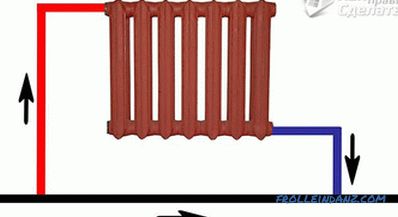 The principle of operation of a single pipe home heating system
The principle of operation of a single pipe home heating system
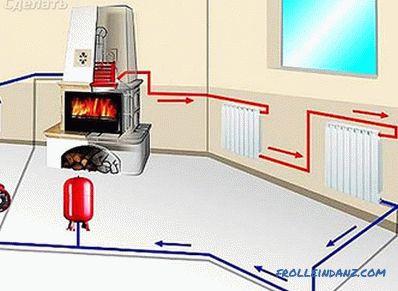 Water heating circuit with forced circulation
Water heating circuit with forced circulation
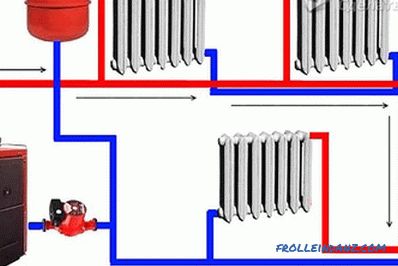 Single pipe forced heating system
Single pipe forced heating system 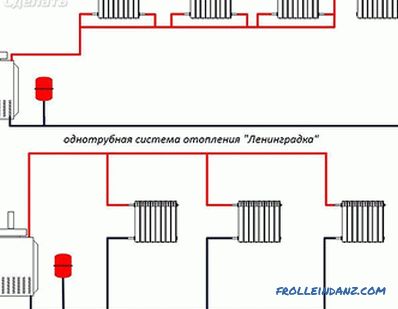 Species
Species
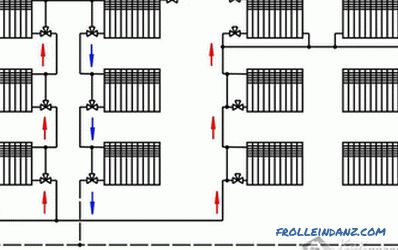 Battery connections
Battery connections
